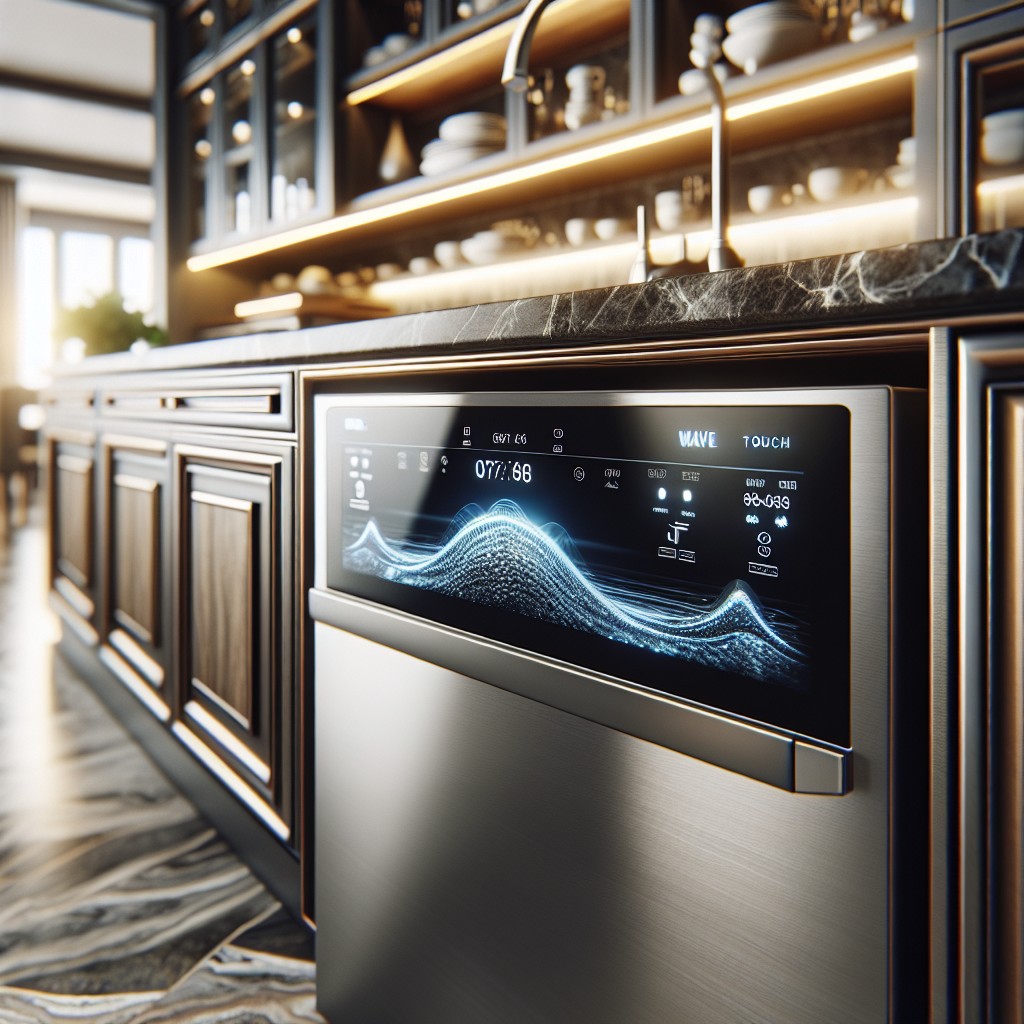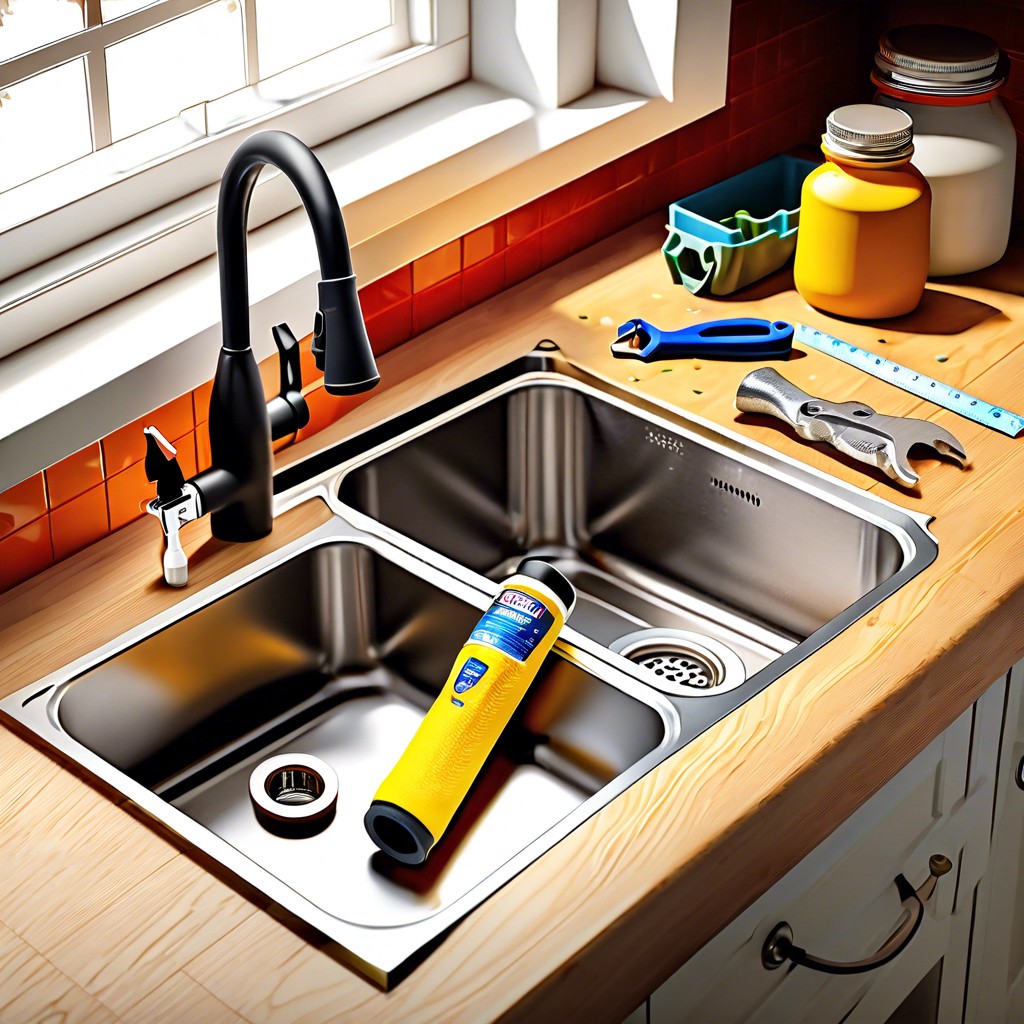Last updated on
Explore the striking details of Wave Touch and IQ Touch appliances because their unique features create a remarkable, user-friendly experience in the kitchen.
Delving into the world of modern kitchen appliances, you’ll inevitably encounter two of Electrolux’s distinguished technologies: Wave-Touch and IQ-Touch Controls. Both offer sleek aesthetics and advanced features, yet they have their own unique advantages.
The Wave-Touch controls reveal your control panels with a touch and fade away when not in use, maintaining a clean and uncluttered facade. Conversely, IQ-Touch keep all your options visible, always ready for an easy selection.
As you press on, this detailed comparison will comprehensively dissect these technologies to help you determine which control type better aligns with your lifestyle, usability preferences, and design aspirations. Stay tuned to uncover all the details!
Key takeaways:
- Wave Touch and IQ Touch offer sleek aesthetics and advanced features.
- Wave Touch controls fade away when not in use, while IQ Touch keeps all options visible.
- Wave Touch is sensitive to nuanced changes, while IQ Touch excels in responsiveness.
- Wave Touch is more precise, while IQ Touch offers consistent accuracy.
- Wave Touch is durable with spill-proof surfaces, while IQ Touch is resistant to wear and tear.
What's Inside
Brief Overview of Wave Touch Technology

Wave Touch technology is a revolutionary approach to user interfaces. Its primary feature is sensitivity to a user’s touch, triggering responses to nuanced changes such as slight waves or gentle touches. This responsiveness is achieved through precise sensors that detect slight motions, facilitating an enhanced interaction experience.
The technology is called ‘wave’ because users can use their hands, not just a fingertip, to control the device. These sweeping hand gestures allow scrolling through menus, adjusting settings, and more. It’s like an enhanced touch screen that responds to many more types of interactions beyond simple finger tapping.
Wave Touch can be found in a variety of applications, from home appliances like dishwashers and refrigerators to technological devices like tablets and computers. The flexibility and user-friendly nature of Wave Touch technology have earned it a significant presence in the modern gadget and appliance markets.
Brief Overview of IQ Touch Technology

IQ Touch Technology utilizes an intuitive user interface found in various appliances, such as refrigerators or oven ranges. At its core, this technology allows seamless interaction between the user and the appliance. This is achieved through a highly responsive touchscreen panel, transforming the user experience.
With the aim of enhancing user convenience, IQ Touch comes with easy-to-use control settings. These incorporate bright, considerately designed icons that alert you of the appliance’s status at a glance.
Moreover, the IQ Touch panels are known for their alluring aesthetics. They merge modern design with practical function, providing an edge of sophistication to appliances. Additionally, they shine in durability, being designed to withstand daily, frequent use.
Lastly, one of the significant features is the lockout option available in IQ Touch panels. This function gives you control over who can operate the appliance – a valuable feature for households with small children.
Technical Specifications of Wave Touch
Delving deeper into the components, let’s explore some interesting details of Wave Touch technology. This advanced system is characterized by its simplistic interface, where a simple wave of the hand can actuate a function. Typically, it comes with control panel that is entirely blank, revealing the controls only when touched or waved at.
The hardware of Wave Touch devices involves the use of capacitive touch sensors. These sensors can effectively detect changes in electrical charges and result in a more fluid user experience with swift responsiveness.
Regarding energy consumption, Wave Touch screens generally consume less power compared to conventional touch screens. They are also designed to go into a sleep mode when not in use, further conserving energy.
Additionally, the technology accommodates a variety of environments and lighting conditions. Its robust construction offers superior resistance to dust, heat, and humidity, making it suitable for different applications.
Lastly, Wave Touch technology can be configured to identify and respond to different wave patterns, increasing the potential for customization according to specific user needs. This intelligent design caters to an intuitive user journey, making it relatively easy to adopt in various applications.
Technical Specifications of IQ Touch
IQ Touch stands out due to its capacitive touch technology. This unique feature offers highly responsive and interactive functions for users. The technology encompasses an overlay attached to the device’s display. Thin metallic layers within this structure facilitate touch sensing.
The effectiveness of IQ touch relies on the interaction between human fingers and an electronically charged screen. This touch technology is sufficiently sensitive to detect not only touch but also the pressure applied, allowing for a wider range of input options.
IQ Touch systems are designed for versatility, compatible with diverse screen sizes ranging from compact phones to large monitors. They are calibrated to operate under varying light conditions and offer multi-touch capabilities, providing enhanced usability.
It’s advantageous to note that IQ touch requires consistent electricity flow for optimal performance. It might consume higher power compared to resistive touch screens, which is a factor to consider for battery-dependent devices.
Regarding durability, IQ Touch devices maintain their sensitivity even when the screen is slightly damaged. This owes to the fact that the touch functionality is integrated into the electronic display itself, making it less susceptible to external environmental factors.
Overall, while considering IQ Touch technology, the key takeaways are its high sensitivity, multi-touch capabilities, wide-range compatibility, light condition adaptability, and power requirements.
Comparing Responsiveness in Wave Touch and IQ Touch
With Wave Touch technology, actions are triggered by waving a hand or finger over the screen – no physical contact required. This enhancement in responsiveness provides a smooth and gesture-rich user experience. Notably, response time in Wave Touch systems is minimal, ensuring immediate interaction with the display.
IQ Touch, on the other hand, necessitates direct touch for activation. This technology excels in recognising multi-touch inputs concurrently. Its high sensitivity to minute touch variations contributes to the overall responsive experience. Though slightly slower in response time than Wave Touch, the difference is barely noticeable to the user.
Key factors like sensitivity, tracking accuracy, and multi-touch capability affect the responsiveness of both platforms. Understanding these characteristics will assist in choosing the right technology that aligns with specific user interaction needs.
Analyzing Accuracy and Precision in Wave Touch and IQ Touch
While both technologies promise a high degree of accuracy, precision varies between Wave Touch and IQ Touch interfaces.
The Wave Touch technology stands out with its ability to register slightest nuances of tactile interaction. It has been lauded for its precision related to distinguishing between intentional touch and incidental contact, eliminating unnecessary triggering. This precision makes it a preferred choice for applications that demand fine-tuned interaction.
Meanwhile, IQ Touch is recognized for its consistent accuracy across the touch interface. Its high sensitivity sensors ensure that every touch, irrespective of its place on the screen, is registered accurately, giving it a reliable score for standardized responsiveness.
Both technologies adhere to high standards of accuracy and precision, it boils down to individual requirements, whether the need is for finely-detailed responsiveness or widespread consistent accuracy.
Checking the Durability: Wave Touch Vs IQ Touch
Wave Touch technology, often found in modern kitchen appliances, is known for its durability. It’s designed to withstand frequent use and has a spill-proof surface that can easily be cleaned. Long-term testing shows that it remains responsive even after repeated touch inputs, guaranteeing its resilience over time.
On the other hand, IQ Touch devices boast high-level endurance as well, especially notable in high-traffic areas such as public kiosks. This technology is engineered to resist wear-and-tear, including scratches and weather-induced damage. Hence, users can expect reliability and long-standing performance.
Both technologies thus offer impressive durability. Your choice will ultimately depend on specific design and application needs. Opt for Wave Touch for an environment with potential liquid spills, while IQ Touch is perfect in high-use public areas with risk of physical damage or outdoor weather elements.
Consumer Electronics Applications for Wave Touch and IQ Touch
In the world of consumer electronics, both technologies have made a significant footprint. Wave Touch is favored in high-end appliances like refrigerators and ovens for its sleek, minimalistic design. It eliminates physical buttons, allowing functions to be accessed by waving a hand over the touch-sensitive panel.
On the other side, IQ Touch has made its home in devices such as washing machines, dryers, and dishwashers. Boasting a more traditional approach, it allows users to control device functions via an easily accessible and user-friendly touchscreen interface. The touchscreen typically displays options only relevant to the current task, avoiding technophobia and offering a more intuitive user experience.
In both cases, manufacturers aim at facilitating user interaction, adding a touch of innovative technology to everyday tasks. Each system serves different audiences and usage scenarios, accounting for a variety of preferences in the broad consumer electronics market.
Industrial Applications of Wave Touch and IQ Touch
In the industrial realm, both technologies have carved noteworthy niches. Wave Touch is often the go-to for industries seeking robust, heavy-duty applications. This preference attributes to its high resistance to environmental factors, like dust and water. This trait allows it to shine in settings such as manufacturing plants, outdoor kiosks, and industrial control systems.
On the other hand, IQ Touch is a popular choice for industries emphasizing precision and enhanced functionality. You’ll see it often employed in medical and healthcare sectors due to its high accuracy. It shines in complex machinery control or diagnostics tools, where slight variations can make significant differences. Advanced grading and inspection systems also use this technology, capitalizing on its capacity for detailed, multi-point touch recognition.
Financial Implications of Choosing Between Wave Touch and IQ Touch
While both technologies offer high-end features, their cost may vary significantly. Wave Touch, being a more sophisticated technology, is usually found in premium devices, making it a pricier option. In contrast, IQ Touch, despite providing a comprehensive interactive experience, is generally more cost-effective, appearing in a broader range of devices.
Maintenance costs also differ. IQ Touch systems, due to their simpler design, typically incur lower repair and maintenance expenses. Wave Touch systems, with their advanced technology, might require more specialized servicing, increasing the overall cost.
Consider the device’s purpose before making an investment decision. For an everyday-use device with basic functions, an IQ Touch interface might suffice. However, for a high-end device requiring superior accuracy and responsiveness, the cost of a Wave Touch interface could prove worthwhile.
Don’t forget to factor in the device’s anticipated lifespan. While higher upfront costs may be daunting, the price might be justified over an extended usage period. Always remember to analyse the total cost of ownership, not just the upfront cost.
Furthermore, examine warranty and after-sales services. Reputable brands often provide comprehensive coverage, which can help mitigate any additional costs. Be sure to read the fine print and understand the specifics before proceeding. Finally, consider potential resale values. Devices with Wave Touch technology, due to their high quality, might fetch you a more substantial return if you plan to upgrade in the future.
User Interaction and Navigation On Wave Touch and IQ Touch Interfaces
The Wave Touch and IQ Touch interfaces both come with their own unique approaches to user interaction and navigation. In a Wave Touch system, navigation is truly a touchless experience. A simple wave of your hand over the sensor, and your command is executed. It’s designed to be highly intuitive, adding a new level of convenience to modern technology interfaces.
On the other hand, IQ Touch requires actual contact with the screen to respond. That’s not a drawback, it’s a design choice. It interacts with users via a user-friendly digital display panel, with commands executed at a single touch. The learning curve here is minimal since it shares similarities with smartphone navigation.
Neither interface gives the other a wide berth in terms of ease of use. However, Wave Touch appears to be more ‘hands-free’, while IQ Touch may feel more familiar to avid technology users because of its similarities with widely-used gadgets.
Assessing the Customizability of Wave Touch and IQ Touch
Both Wave Touch and IQ Touch systems offer a level of customizability, allowing users to establish preferred settings for their convenience.
The Wave Touch technology emphasizes adaptability. Its interface showcases icons only when a function is in use, creating a clean and uncluttered appearance. Users can easily adjust settings to cater to their requirements, providing the flexibility to handle a variety of tasks.
On the IQ Touch front, it provides a persistent display of all options. Its intuitive control setup assists users in effortlessly selecting and adjusting settings. The availability of a favorites button further enhances customization, allowing users to save commonly used settings for easy access.
It’s essential to examine the extent each system permits changes to suit your specific needs as this could significantly affect your user experience. Balancing the system’s versatility against its simplicity is worth considering when comparing the customizability of Wave Touch and IQ Touch technologies.
Decision-Making Criteria: Choosing Between Wave Touch and IQ Touch
Examining several factors can guide in selecting either Wave Touch or IQ Touch as the preferred technology. Consider the following decision-making criteria:
Purpose: Are you searching for precision and dedicated touchpoints, or a more free-flowing, flexible interface? If it’s the former, IQ Touch may be desirable, while Wave Touch is more suited to the latter.
Budget: Consider the financial constraints. Wave Touch tends to be more costly due to its sophisticated design, while IQ Touch is relatively affordable.
Durability: How hard-wearing does the technology need to be? If durability is a priority, consider IQ Touch, known for its longer lifespan.
Customizability: If you place a premium on a personalized interface, Wave Touch, with its highly adjustable settings, could be the better pick.
User Experience: Examine your expected user interaction levels. For fast-paced, intensive interactions, Wave Touch‘s swift responsiveness may be beneficial. If navigation is more critical, IQ Touch‘s clear touchpoints may prove more intuitive.
These considerations should help steer the selection process for the most suitable technology according to your unique requirements, without making a final verdict for either technology.
Commonly Asked Questions On Wave Touch and IQ Touch
Sure, let’s tackle some frequently asked queries:
1. “What makes Wave and IQ touch interfaces distinct?”
– The primary difference lies in responsiveness and interaction style. Wave touch relies on a gesture-based system, while IQ touch incorporates enhanced precision using touch points.
2. “Do both technologies support multi-touch gestures?”
– Yes, both interfaces support multi-touch gestures, facilitating enhanced user interactions.
3. “Is one more durable than the other?”
– Durability depends on device construction rather than the touch interface itself. However, wave touch interfaces are often sealed units and can withstand more harsh conditions.
4. “Which one is more cost-effective?”
– It varies based on the specific model and its features. IQ Touch tends to be more cost-efficient in consumer electronics, while Wave Touch is often preferred for high-end industrial applications due to its robustness and reliability.
5. “Can these touch interfaces be customized?”
– Yes, developers can adapt both interfaces to specific requirements, ensuring a tailored user experience.
Remember to research thoroughly before deciding between Wave Touch and IQ Touch to choose the system that best suits your needs. Your choice could significantly impact user satisfaction and device efficiency.




